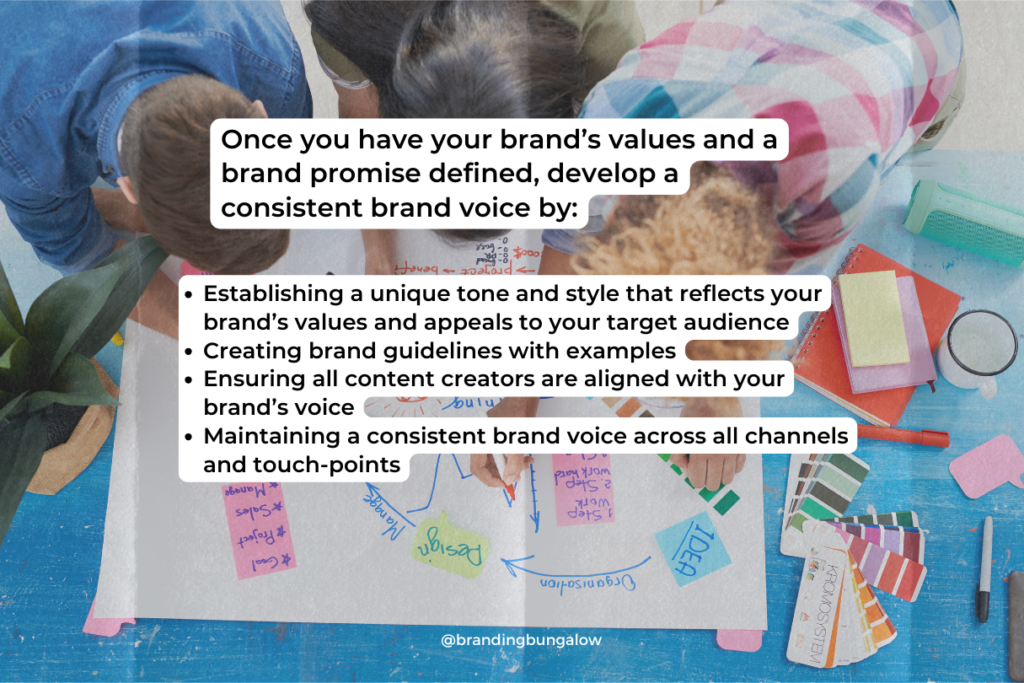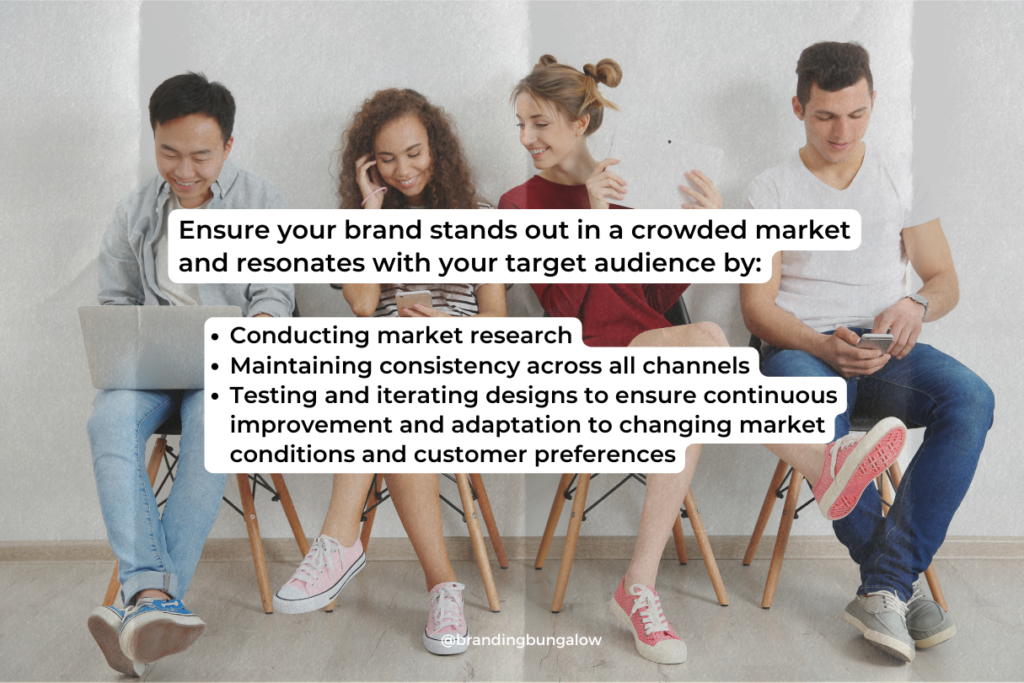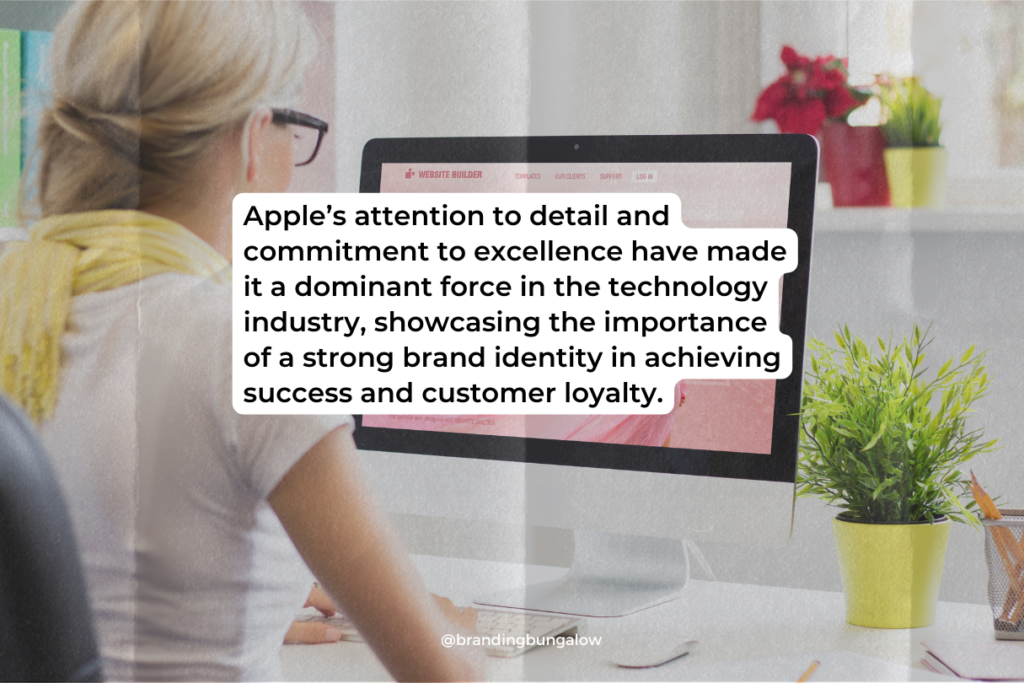Brand Identity Creation: A Guide to Branding Design
In a world where countless brands compete for attention, how do some manage to rise above the noise and have a brand identity become instantly recognizable? The answer lies in the power of branding design. A well-crafted brand identity can evoke emotions, foster loyalty, and create a lasting impression on potential customers. In this blog post, we will explore the essentials of branding design and how you can create a strong brand identity that not only stands out but also resonates with your target audience.
Key Takeaways
- Branding design is the art of creating a unique visual identity and emotional connection with customers to build recognition & loyalty.
- Key components include logo, color palette selection, typography/fonts, imagery/iconography & crafting your brand story.
- Best practices involve conducting market research, maintaining consistency across channels and testing designs for relevance.
The Essence of Branding Design and Brand Identity

Brand design is the visual representation of a company’s identity, encompassing visual elements and emotional connections that resonate with the target audience. From the logo to the unique color palette, brand design plays a crucial role in building brand recognition and loyalty. When done right, brand design can make a brand unique and instantly recognizable. It sets the brand apart from competitors and makes it an essential part of the everyday life of its customers.
Developing a robust brand identity involves two major components: the impact of visual elements and the significance of emotional connection. These aspects work hand-in-hand to create a brand that not only looks great but also feels authentic and relatable.
The Role of Brand Identity Visual Elements
Visual elements are essential for creating a visually appealing and memorable brand identity. They can bring your brand to life and make it stand out in a crowded market. The core brand elements of branding design include:
- Logos
- Colors
- Typography
- Imagery
Each of these elements contributes to building a unique visual identity that perfectly reflects your brand values and personality.
For example, a company logo is often the first thing that comes to mind when someone thinks of a brand. It should be carefully crafted to represent the essence of the company and its values, instantly catching the eye of the target audience. Similarly, selecting the right color palette can evoke specific emotions and create a sense of consistency. Thoughtful typography choices contribute to the overall brand personality. By combining these visual elements with purpose and intention, you can create a brand identity that leaves a lasting impression and stands out amongst competition.
Brand Identity Emotional Connection
Though visual elements are fundamental in crafting a recognizable and attractive brand identity, establishing an emotional connection with the audience truly cultivates loyalty and enduring relationships. A well-designed company logo or color palette might catch the eye, but it’s the emotions and experiences associated with the brand that keep customers coming back.
Establishing an emotional connection is possible by adhering to your brand values, engaging customers in the process, and narrating compelling stories that connect with your target audience. These connections can help build a unique visual identity for your brand. They can also strengthen the bond between your company and its customers, setting the stage for lasting success and loyalty.
Key Components of Branding Design in Brand Identity

Developing a unified brand identity necessitates concentration on primary elements of branding design, such as:
- Logo design
- Color selection
- Typography
- Imagery
Each of these components plays a vital role in defining your brand and ensuring its connection with your target audience. By carefully considering and crafting each element, you can create a strong, consistent, and memorable brand identity.
The subsequent sections examine these components in greater depth, offering guidance on crafting a comprehensive and effective brand identity. Understanding and implementing these elements will help you build a brand that stands out and resonates with your target audience.
Logo Design
Logo design serves as the fundamental element of branding, signifying the core of a company and its values. A well-crafted brand’s logo should be memorable, visually appealing, and easily identifiable. It serves as the foundation upon which the rest of your brand identity is built, making it an essential component of your branding design efforts.
When designing a logo, it’s important to consider the target audience, the company’s values, and the message you want to convey. A good logo should be versatile and adaptable, working well across various platforms and media. It’s also crucial to ensure that your logo is consistent with the overall brand identity. This includes the color palette, typography, and imagery.
Crafting a logo that precisely embodies your company and its values sets the path for building a robust brand identity that connects with your audience.
Color Palette Selection

Choosing a color palette is imperative for inducing particular emotions and impressions. It aids in the creation of a uniform brand image. The right color palette can make your brand instantly recognizable and set the tone for your entire visual identity. In addition, colors can influence how your brand is perceived and help to convey your brand values and personality.
When choosing a color palette for your brand, consider the emotions and feelings you want to evoke, as well as the message you want to communicate. It’s important to select colors that align with your brand values and resonate with your target audience. Additionally, a well-defined color palette can make it easier for designers to create consistent marketing collateral. The consistency in design will ensure that your brand is easily recognizable across various platforms.
By carefully selecting your brand colors, you can create a cohesive and visually appealing brand identity that leaves a lasting impression on your audience.
Typography and Font Choices
Typography and font choices contribute to the overall brand personality and should be carefully selected to align with your brand’s values. The fonts you choose for your branding design can have a significant impact on how your brand is perceived. Fonts help convey your brand’s unique identity and personality. In addition, typography plays a crucial role in the readability and accessibility of your marketing collateral. You want to ensure that your message is clear and easily understood.
Choosing fonts for your branding design requires selecting a combination of typefaces that complement each other and embody your brand’s personality. This may involve:
- Selecting a primary font for headlines
- Selecting a secondary font for body text
- Considering how different font weights and styles can be used for various purposes
By carefully selecting and using typography in your branding design, you can create a consistent and visually appealing brand identity that effectively communicates your brand values and message.
Imagery and Iconography
Imagery and iconography help convey complex information in a simple and visually appealing manner, enhancing brand recognition and trust. Using images, illustrations, and icons can make your brand more engaging and help communicate your brand’s message more effectively. In addition, well-designed imagery and iconography can create a cohesive visual identity that strengthens your brand’s overall image.
When incorporating imagery and iconography into your branding design, it’s important to choose visuals that align with your brand values and resonate with your target audience. This may involve selecting specific types of images, illustrations, or icons that reflect your brand’s personality and message. By ensuring that your imagery and iconography are consistent with your overall brand identity, you can create a visually appealing and memorable brand that effectively communicates your brand’s unique identity and values.
Crafting Your Brand Story

Creating a brand story entails defining brand values, formulating a brand promise, and cultivating a consistent brand voice. Your brand story is the narrative that defines your company and sets it apart from the competition. It helps to communicate your brand’s unique identity, values, and purpose, making it an essential component of your branding design.
To weave an engaging brand story, concentrate on the elements that distinguish your brand and connect with your target audience. In the following sections, we’ll discuss how to establish your brand values, create a brand promise, and develop a consistent brand voice. These components contribute to a powerful and engaging brand story that sets your company apart from the competition.
Establishing Your Identity: Brand Values
Brand values guide your company’s actions and decisions, ensuring alignment with the expectations of your target audience. They form the foundation of your brand story, helping to define your brand’s unique identity and personality. Establishing clear and consistent brand values creates a strong, relatable brand identity that sets your company apart from the competition.
When defining your brand values, consider the company’s core beliefs and the impact you want to have on your customers. This may involve brainstorming with your team, conducting market research, and analyzing customer feedback to identify the values that truly capture the essence of your brand. Establishing clear and consistent brand values creates a powerful brand story that reflects your company’s unique identity. Defined brand values also build an emotional connection with your audience.
Creating a Brand Promise
A brand promise communicates the benefits and experiences customers can expect from your company, setting it apart from competitors. It should be a clear and concise statement that reflects your brand values and speaks to the needs and desires of your target audience. By creating a compelling brand promise, you can establish trust and credibility with your customers, ensuring that they choose your brand over the competition.
To craft a powerful brand promise, consider the unique value proposition your company offers and the impact it has on your customers’ lives. This may involve conducting market research, analyzing customer feedback, and identifying the key differentiators that set your brand apart from the competition. By focusing on the benefits and experiences your brand delivers, you can create a brand promise that not only resonates with your target audience but also sets the stage for long-term success and customer loyalty.
Developing a Consistent Brand Voice
A consistent brand voice helps maintain a cohesive brand identity across all channels and touch-points, enhancing brand recognition and trust. Your brand voice is the unique tone and style that reflects your brand’s values and personality, making it an essential component of your branding design efforts. By using a consistent brand voice across all channels, you can ensure that your brand is easily recognizable and memorable, building trust and credibility with your audience.
To develop a consistent brand voice, it’s important to:
- Establish a unique tone and style that reflects your brand’s values and appeals to your target audience
- Create brand guidelines and provide examples of desired voice and messaging
- Ensure that all content creators are aligned with your brand’s voice
- Maintain a consistent brand voice across all channels and touch-points
By doing so, you can create a cohesive and powerful brand identity that sets your company apart from the competition and resonates with your target audience.
Best Practices for Effective Branding Design for Your Brand Identity

Developing a successful branding design goes beyond simply choosing appropriate visuals and weaving an engaging brand story. It also requires adopting best practices that ensure your brand stands out in a crowded market and resonates with your target audience. Some of these best practices include:
- Conducting market research
- Maintaining consistency across all channels
- Testing and iterating designs to ensure continuous improvement and adaptation to changing market conditions and customer preferences
By following these best practices, you can create a strong and effective brand that captures the attention and loyalty of your audience.
The subsequent sections will delve deeper into these best practices, offering suggestions on crafting a branding design that not only stands out but also connects with your target audience. By adopting these best practices, you’ll be well on your way to building a strong and memorable brand that drives success and customer loyalty.
Market Research and Competitor Analysis
Market research and competitor analysis are essential for identifying gaps and opportunities in the market, informing your branding design decisions. By understanding the competitive landscape and the needs and preferences of your target audience, you can create a branding design that sets your company apart and resonates with your customers.
Conducting market research and competitor analysis involves defining your target audience, analyzing competitors, and conducting consumer research to identify trends and preferences. Stay informed about market conditions and customer needs. Consequently, consider how you can align your branding design with the market and target audience.
This not only helps to create a strong brand identity but also enables you to adapt and evolve your branding design as market conditions and customer preferences change.
Identity Consistency Across All Channels
Ensuring consistency across all channels is critical for maintaining a cohesive brand identity and enhancing brand recognition and trust. By using consistent visuals, messaging, and tone of voice across all platforms and communication channels, you can create a recognizable and memorable experience for your customers that reinforces your brand values and personality.
Some strategies for maintaining brand consistency across channels include:
- Establishing clear brand guidelines
- Ensuring that visuals are uniform across channels
- Generating high-quality content
- Monitoring and evaluating your content’s tone regularly
By adopting these strategies, you can create a cohesive and visually appealing brand identity that effectively communicates your brand’s unique identity and values across all channels and touch-points.
Testing and Iteration
Testing and iterating designs allows for continuous improvement and adaptation to changing market conditions and customer preferences. By seeking feedback from your target audience and making adjustments based on their input, you can ensure that your branding design resonates with potential customers and conveys the right message about your brand.
Some methods for successful testing and iteration include:
- Using early prototypes to test assumptions and gather feedback
- Recognizing that design is an iterative process
- Refining your products based on user feedback
By adopting these strategies, you can continually improve your branding design and adapt to changing market conditions and customer preferences, ensuring that your brand remains relevant and compelling to your target audience.
Inspirational Branding Design Examples
Iconic brands such as Apple, Coca-Cola, and Nike showcase the power of strong brand identity in driving success and customer loyalty. These brands have created memorable branding designs that stand out in a crowded market and engage their target audience. Examining these brand design inspiration examples can provide useful insights and inspiration for your own branding endeavors.
Let’s examine each of these iconic brands and identify the key aspects of their branding design that have led to their success and sustained customer loyalty.
Apple

Apple’s branding design is synonymous with:
- Sleekness
- Cutting-edge innovation
- Creativity
- Premium quality
- Exclusivity
From the evolution of their iconic logo to their consistent use of minimalist design elements, Apple has managed to create a powerful brand identity that resonates with customers worldwide.
Their attention to detail and commitment to excellence have made Apple a dominant force in the technology industry, showcasing the importance of a strong brand identity in achieving success and customer loyalty.
Coca-Cola
Coca-Cola’s branding design centers around the theme of happiness, experiences, and emotions. Some key elements of their branding include:
- Iconic red color
- Balanced logo
- Consistent messaging
- Focus on selling experiences
These elements have helped Coca-Cola create a globally recognizable brand and foster a deep emotional connection with consumers.
By creating a powerful and consistent brand identity, Coca-Cola has managed to build customer loyalty and establish itself as a dominant brand in the beverage industry.
Nike
Nike’s branding design is characterized by strong branding reinforcement, relatability, and a focus on lifestyle and sport community positioning. Their iconic swoosh logo, bold colors, and inspirational slogans have made Nike a favorite among athletes and sports enthusiasts alike.
By creating a powerful and consistent brand identity that resonates with their target audience, Nike has been able to achieve lasting success and customer loyalty.
Summary
In conclusion, creating a strong brand identity through effective branding design is crucial for success in today’s competitive market. By focusing on the key components of branding design, such as logo design, color palette selection, typography, and imagery, and adopting best practices like market research and consistency across channels, you can build a memorable and engaging brand that resonates with your target audience. Learn from iconic brands like Apple, Coca-Cola, and Nike. These brands provide valuable insights and inspiration to create your own powerful brand identity that drives success and customer loyalty.
Frequently Asked Questions
What is the meaning of branding design?
Branding design refers to visual components that make a brand easily recognizable to consumers such as its logo, color scheme and typography.
What is the design process for branding?
The design process for branding involves research, strategy, and design stages, followed by implementation or execution. Immersion can be used instead of research, and planning instead of strategy.
What are the main visual elements of branding design?
The main visual elements of branding design are logos, colors, typography, and imagery – all working together to help create an instantly recognizable brand.
Why is emotional connection important in branding design?
Creating an emotional connection with customers through branding helps to foster customer loyalty, builds trust, and establishes strong long-term relationships.
How can market research and competitor analysis inform branding design decisions?
Market research and competitor analysis can provide valuable insights into target audiences and competitors that inform your branding design decisions.
Recent Blog Entries
Discounts to Dubsado CRM, Helcim Payment Processing and...
Brand audits can save your business' sinking marketing ship.
What's happening to Coke and what you can learn from it.
Shop Products
Create a personalize brand board by taking elements from our 3 signature brand board templates.